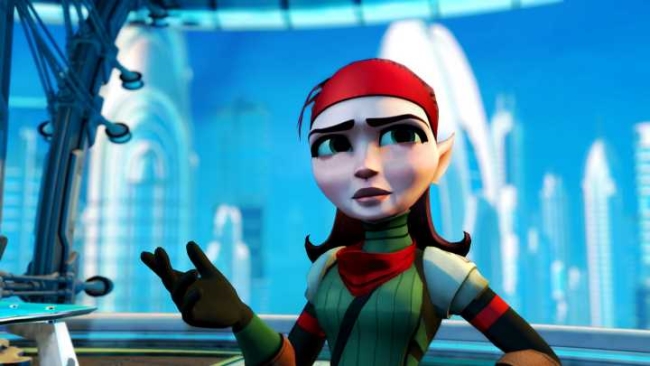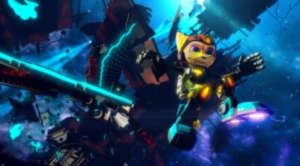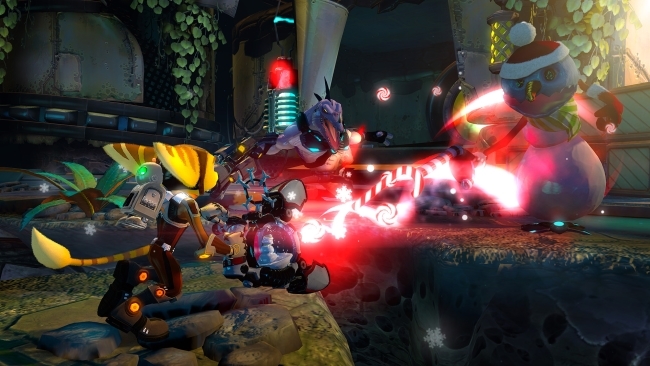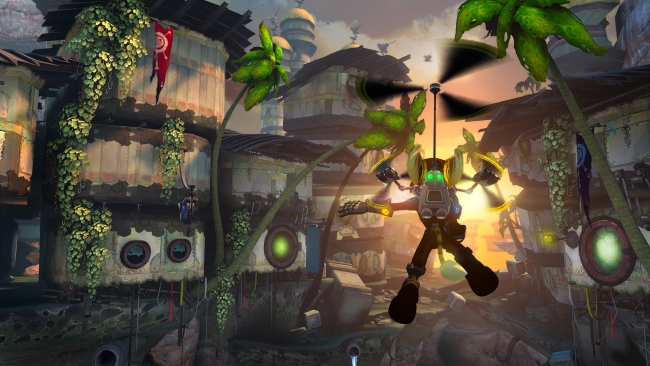
Since the 2009 title, A Crack in Time, Ratchet and Clank have been trying a lot of new things. After a cooperative family adventure and a foray into competitive multiplayer, Insomniac Games promised the intergalactic heroes would see a return to their roots in Ratchet & Clank: Into The Nexus (or Nexus, depending on your region). The great excitement fans experienced with the announcement of a “traditional” Ratchet & Clank title unfortunately also gave them reason for disappointment. Rather than the lengthy format of fan favourite titles in the series, Nexus is a shorter game, which in compensation comes at a lesser price. Such a decision begs the question; can a traditional Ratchet & Clank game be considered as such, despite breaking the tradition of their length?
 Having grown up playing Ratchet & Clank, the offer of having an experience that could remind me exactly what made me fall in love with the fuzzy-eared lombax and his little metallic pal in the first place was one I couldn’t pass up. Other fans of the series made it clear they felt the same way. Whether on PlayStation Blog posts, YouTube videos, or Insomniac Games’ social media pages, fan excitement, appreciation and interest has been prevalent. Sure, the fanbase may not be comparable in size to that of Call of Duty, Assassin’s Creed, or the other large franchises that dominate every November, but there is certainly a cragmite army’s worth of people who are passionate about Ratchet and Clank, and they aren’t shy about what they’d like to see in their action-platformer of choice. So, Insomniac face a problem; how do they expand and evolve the series without disappointing the loyal fans who love it as it is? Well, if Into The Nexus is any indication to go by, it certainly seems they have a pretty good idea.
Having grown up playing Ratchet & Clank, the offer of having an experience that could remind me exactly what made me fall in love with the fuzzy-eared lombax and his little metallic pal in the first place was one I couldn’t pass up. Other fans of the series made it clear they felt the same way. Whether on PlayStation Blog posts, YouTube videos, or Insomniac Games’ social media pages, fan excitement, appreciation and interest has been prevalent. Sure, the fanbase may not be comparable in size to that of Call of Duty, Assassin’s Creed, or the other large franchises that dominate every November, but there is certainly a cragmite army’s worth of people who are passionate about Ratchet and Clank, and they aren’t shy about what they’d like to see in their action-platformer of choice. So, Insomniac face a problem; how do they expand and evolve the series without disappointing the loyal fans who love it as it is? Well, if Into The Nexus is any indication to go by, it certainly seems they have a pretty good idea.
Ratchet & Clank: Into The Nexus is set after the events of all the previous games, but has also been described by the developers as being an epilogue to the Ratchet & Clank: Future Trilogy. The connection to these games specifically is very clear, with a plot which covers very similar themes as those defined in the trilogy, but instead utilises a much more cinematic approach to storytelling; which was arguably lacking in the previous two releases.
 The tale begins with the duo assisting in the transport of a criminal named Vendra Prog, who has been sentenced to imprisonment at the Vartax Detention Centre for unmentioned crimes. Having come from the supposedly haunted Zarkov Sector of space, Vendra is considered a “Space Witch”, and thus, the reasons for this title quickly become apparent when she starts using her powers to manipulate the Nebulox Seven Prison Ship in order to escape. Altering gravity, opening and closing airlocks, real “witchy” stuff. Shortly hereafter, Neftin Prog, Vendra’s brother, launches an attack on the vessel, breaking Vendra from her confinement and leaving our heroes stranded on Yerek; an unknown planet, where they must now attempt to track down the escaped criminals.
The tale begins with the duo assisting in the transport of a criminal named Vendra Prog, who has been sentenced to imprisonment at the Vartax Detention Centre for unmentioned crimes. Having come from the supposedly haunted Zarkov Sector of space, Vendra is considered a “Space Witch”, and thus, the reasons for this title quickly become apparent when she starts using her powers to manipulate the Nebulox Seven Prison Ship in order to escape. Altering gravity, opening and closing airlocks, real “witchy” stuff. Shortly hereafter, Neftin Prog, Vendra’s brother, launches an attack on the vessel, breaking Vendra from her confinement and leaving our heroes stranded on Yerek; an unknown planet, where they must now attempt to track down the escaped criminals.
Though it might sound like quite a generic premise, the character motivations and the situations they find themselves in could have developed into a very engrossing plot. Don’t get me wrong, what’s here is good, but it’s not dynamic and doesn’t feel fully realised. And whilst foundations are built for certain characters to share motivations, to have an interesting dynamic to their relationship, or just to lead to a humorous outcome, the story ends up feeling like a checklist, rather than a gradually progressing narrative. I felt like I was going from one plot-point to the next, with no substance in-between. Even though characters tend to have conversations during gameplay, it rarely felt meaningful. Honestly, it more so came across as a way for the developers to say “hey player, do this next!”, rather than building a genuine conversation between Ratchet and one of his colleagues.

However, the area where Into The Nexus really shines is in the personalities of its characters, and the consistent quality of the writing. Additionally, Its also great to see new villains making a debut, as well as several characters from the series returning, some of which have been sorely missed. The modestly brilliant Captain Qwark, the conspicuous Plumber, the shady Smuggler, Talwyn and her warbot curators Cronk and Zephyr all return, and are as humorous, likable, and entertaining as ever. Every line of dialogue, every body movement, and every facial expression reflects these well-loved characters’ personalities, and the writing and animation are immaculately executed. The quality of the writing goes beyond this however, and extends even into the user interface. This is a game in which you’ll want to read the description of each difficulty option, just for the comedic value.
The formula is simple. You explore the environment, jumping holes and breaking crates. The crates burst open showering you with bolts (the game’s currency). You spend bolts buying and upgrading your firearms of choice. You take your shiny new explosives and artillery to the battlefield and grab more bolts. The skeleton of Nexus is familiar, yet the flesh has made an undeniable step forward. It almost bears as much resemblance to a modern third person shooter as it does to a PS2 platformer, in what I found to be a perfect balance between styles.
 Insomniac’s intentions to recapture the essence of Ratchet & Clank is blatantly obvious through the things they’ve chosen to revive or reinvent from earlier entries in the franchise. As a fan of the series, I found myself thinking “whoa, this Jet Pack is just like the Levitator from Ratchet 2!” or “nice, Planet Thram is like Planet Sargasso with Hoverboots!”. There are just so many resemblances to specific points in the franchise’s decade long history, but each of them is an improvement and a refinement in a way that makes Nexus feel like a collection of some of the heights of the series. The branching paths of Yerek and the open nature of Thram offer interesting level structures that create a fantastic feeling of adventure and exploration. I felt like I was scouting new worlds rather than simply running along a new road. Though other planets in the game feel more like the latter, the diversity in level structure improves the game more than I feel a consistent approach would have. Admittedly, I would have loved to play through some more open locales, but not at the expense of the more linear planets in the game.
Insomniac’s intentions to recapture the essence of Ratchet & Clank is blatantly obvious through the things they’ve chosen to revive or reinvent from earlier entries in the franchise. As a fan of the series, I found myself thinking “whoa, this Jet Pack is just like the Levitator from Ratchet 2!” or “nice, Planet Thram is like Planet Sargasso with Hoverboots!”. There are just so many resemblances to specific points in the franchise’s decade long history, but each of them is an improvement and a refinement in a way that makes Nexus feel like a collection of some of the heights of the series. The branching paths of Yerek and the open nature of Thram offer interesting level structures that create a fantastic feeling of adventure and exploration. I felt like I was scouting new worlds rather than simply running along a new road. Though other planets in the game feel more like the latter, the diversity in level structure improves the game more than I feel a consistent approach would have. Admittedly, I would have loved to play through some more open locales, but not at the expense of the more linear planets in the game.
The RPG elements that have become common in the series are present here as well. Ratchet’s health increases after collecting enough experience from shooting space-thugs, and weapons will upgrade after a set amount of use. Each upgrade brings an increase in damage, rate of fire, or the like, and in some cases a functional upgrade. The Omniblaster becomes dual Omniblasters, and more defensive weapons add offensive functionality. It’s a device that encourages players and gives them a reason to utilise the entirety of their arsenal. It’s suitably rewarding to have an enormously destructive tool that you’ve created from a much lesser weapon as well. Besides, If you don’t feel that your weapon is devastating enough after these upgrades, you can then customise them even further. As was the case in Tools of Destruction, weapons can be personalized and improved at the expense of raritanium that can be collected from veins of ore spread throughout each planet. Though I love this level of customization, I never felt that my raritanium upgrades were pivotal enough in the resulting weapons. I would have loved to have seen some more notable changes to the arsenal only available from upgrading this way.

Additionally, the player also has access to a selection of gadgets that adds diversity to the pacing of the gameplay. Ratchet can jump between magnetic surfaces while floating in areas with no gravity. The Grav-Tether allows Ratchet to create a stream of gravity between two points, which he can then ride across chasms. The Jet Pack makes high and far away places reachable, as well as enabling aerial combat. The Hoverboots make moving from one place to another a speedy process. All of these gadgets fit well in the series, and are very well implemented. There are points in which the use of these abilities are necessary, adding considerable depth to the levels, and this is where Nexus is at its most interesting. Unfortunately, I found their inconsistency to be a bit disappointing.
The thing is, despite liking the level design and the diversity so much, I do feel that there is a fundamental flaw in the design of the game. As with the plot, I can’t help but feel that Nexus is a big game squeezed into a small package. Don’t get me wrong, I’m not criticizing the game for being short, nor am I suggesting it has too many ideas, but I do think there is a disconnection between the style of the game and the format in which it exists.
 As Ratchet’s arsenal of gadgets and abilities grow, it feels less like they’re contributing towards the possibilities, and more like they’re creating a scenario for the area immediately ahead. certain abilities feel like they’re defined by specific segments, and then made redundant moving forward. Most notably; the zero gravity gameplay you’ll take part in almost immediately makes up nearly the entirety of the first level of the game, but thereafter is only ever revisited once and very briefly. The planet on which you receive the Hoverboots is the only planet there seems to be any reason to have them, and the final planet of the game only requires the use of Ratchet’s gadgets in meaningless, unnecessary ways that feel shoehorned in, rather than adding anything to the gameplay. It’s disappointing that tools, which are introduced to be ancillary, never reach a point of necessity. A planet on which the Hoverboots, Grav-Tether, Jet Pack, and floaty gravity sections intertwine and work together would have been a spectacular circus full of acrobatic fun, and this is an expectation the game hinted towards, but could not deliver.
As Ratchet’s arsenal of gadgets and abilities grow, it feels less like they’re contributing towards the possibilities, and more like they’re creating a scenario for the area immediately ahead. certain abilities feel like they’re defined by specific segments, and then made redundant moving forward. Most notably; the zero gravity gameplay you’ll take part in almost immediately makes up nearly the entirety of the first level of the game, but thereafter is only ever revisited once and very briefly. The planet on which you receive the Hoverboots is the only planet there seems to be any reason to have them, and the final planet of the game only requires the use of Ratchet’s gadgets in meaningless, unnecessary ways that feel shoehorned in, rather than adding anything to the gameplay. It’s disappointing that tools, which are introduced to be ancillary, never reach a point of necessity. A planet on which the Hoverboots, Grav-Tether, Jet Pack, and floaty gravity sections intertwine and work together would have been a spectacular circus full of acrobatic fun, and this is an expectation the game hinted towards, but could not deliver.
Less notably, the collectibles throughout the game felt disappointingly easy to find, especially considering it’s so easy to attain an item which adds all of their locations to your map. I almost felt like I’d wasted my time finding gold bolts and holo-plans for myself once I came across this item that did it for me. I appreciate the decision to put this item in the game, but I would have liked for it to be much harder to gain. The challenge mode (New Game+) in Nexus adds a bolt multiplier that increases as the player amasses kills without being damaged, but collecting the abundance of bolts needed to buy your way to 100% completion still takes longer than I would have liked. After my second playthrough the short length of the game was all the more noticeable, and having to continue grinding through a third playthrough to reach completion seemed unnecessarily monotonous to me.
Fortunately, there is still one aspect of the game that I didn’t find bittersweet, and this was the gameplay. In my opinion, there are no major shortcomings, no disappointment, no unachieved potential, no bitter – just a whole lot of sweet. Ratchet & Clank: Into The Nexus feels very true to the action-platformer style that was proliferated on the PS2, with all modern conveniences and innovations included. It is absolutely the quintessential and best Ratchet & Clank gameplay to date, and I’d be willing to argue that it’s also the best of its genre.
The biggest advancement that makes this title stand out from the series is the mix of manual aiming to shoot, and smooth, precise movement. An automatic lock-on type of shooting gameplay was once a series staple, and though the series introduced the option to aim manually in Up Your Arsenal, it wasn’t until 2012’s Q-Force (or Full Frontal Assault) that it was the predominant option. Though the shooting remains largely the same as that of Q-Force, the movement is precise, responsive, and smooth, unlike the previous release. The best shooting and platforming of its style mixed and balanced together to perfection. The control scheme itself plays an important role too, and the developers clearly thought it through very thoroughly. The fact that the Grav-Tether has a button to itself works wonderfully at the loss of nothing else. Choosing L2 to operate the Jet Pack fits perfectly, as it replaces the holding of L1 which players would otherwise be using to aim. Having R2 used to operate the Hover Boots, as well as R2 and X as the means of performing a Heli-Pack long jump, means the two can be used together succinctly and naturally. The game plays and controls like a dream, down to its very distinct minutia.

Of course, Ratchet’s famous collection of wacky weaponry is back and better than ever; with a healthy combination of completely new weapons, as well as fresh takes on older ideas. The typical pistol, bomb and rocket weapons are included (including a new RYNO), and are as satisfying as ever. However, this time around, Ratchet makes a most notable use of a Winterizer; a weapon that transforms enemies into snowmen whilst playing Christmas music, and a Nightmare Box; a weapon which deploys one of many jack-in-the-box type terrors that frighten and distract enemies. The weapon list expands to more than 10 different means of universe-saving, and each feels unique, useful, and a lot of fun to use. I never found myself using any weapon reluctantly, and was always happy to switch to something else when my side-arm of choice was depleted of ammunition.
It’s worth noting that Clank does get to play a role as well. In short 2D side-scrolling sections, Clank has the ability to shift gravity to any side of the screen, and thus, traverse the area safely and avoid harmful obstacles. In these areas he searches for a nether beast, and lures it back to the entrance. It’s a concept that’s been used in many games before, and it’s not nearly as thoughtful as Clank’s time puzzles in A Crack in Time, but it’s still fun and works well. Additionally, these segments provide a nice break between the gameplay segments as Ratchet.
Whilst Ratchet & Clank doesn’t have the graphical fidelity or realism of something like The Last of Us or Beyond: Two Souls, the gorgeously designed landscapes, the spooky motif, the fantastic animations, and the expressive characters make it an absolute joy to look at. The visual elements of the series are often compared to that of a Pixar film, and it’s not hard to see why. The game is always bright and vibrant, even through the black of space or the darkness of a cave, and each character, weapon and environment is artfully constructed. The way characters move in particular is some of the best animation I’ve seen and is practically flawless. There are the odd few imperfections in the presentation; some textures look a bit flat, specific tree branches are pointier than Link’s nose in Ocarina of Time, and a very, very rare frame-rate drop – but without a doubt, Nexus is a great looking game. Admittedly, the soundtrack isn’t anything particularly memorable, but it’s perfectly suitable for the series, and successfully carries the scary, haunted theme of the game, and is forward driving when it needs to be.

 Captures the best aspects of the series
Captures the best aspects of the series Interesting, non-linear level design
Interesting, non-linear level design Superbly written and presented characters
Superbly written and presented characters Fun, diverse gameplay mechanics
Fun, diverse gameplay mechanics
 Some ideas don’t feel fully realised
Some ideas don’t feel fully realised Collectibles are too easy to find
Collectibles are too easy to find Replay is a little monotonous
Replay is a little monotonous
Ratchet & Clank: Into The Nexus is the game fans, including myself, have been waiting for since 2009; even if it’s less of it than we wanted. Encapsulating the best of the series and improving upon it, Nexus is a perfect example of how a series can grow and improve, while remaining true to its roots, and continue to exist within the definition it has created over many years. Every part of the game is fantastically fun, and the mobility of shooting is, in my opinion, incomparable to any other game and truly unique. With that being said, I believe that any game which utilises character growth deserves the benefit of having more room to develop. However, putting my personal preferences aside, I would still consider Nexus to be one of the best titles available in its price range to date. If Insomniac continue with this direction, not only would I be pleased, but i’m sure a lot of other fans would be too.











